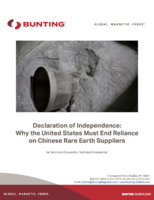Electrical Sensors / Detectors / Transducers
Current Sensors are designed for solar inverters.
Share:
Press Release Summary:
Current sensors monitor ac power output of solar systems into power grid and measure its dc component. Common mode chokes, available for 250/380 V mains operation as well as dc voltages up to 1,000 V, can be installed at inverter input or grid output to block or damp undesired interference voltage levels that could cause EMI between electronic devices. Chokes' nanocrystalline tape wound cores enable construction of filters with long-term temperature stability.
Original Press Release:
VACUUMSCHMELZE Presents High-Precision Current Sensors with Low Offset Current and Common Mode Chokes
Hanau / Frankfurt - Hanau-based VACUUMSCHMELZE GmbH (Hanau) will present its new family of current sensors for solar inverters at this year's electronica (14 to 17 November) in Munich. These sensors are used to monitor the AC power output of solar systems into the power grid and measure its DC component. For operators of solar generators, high-precision current measurement is important since it forms the basis of the feed-in tariff. Unlike conventional Hall element sensors, VACUUMSCHMELZE current sensors offer an array of benefits including extremely low offset current with negligible temperature drift and hardly measurable long-term drift plus high precision.
In a grid-connected system, the direct current produced by the solar modules is converted into the alternating current required for the grid (115 v / 230 v AC voltage) and fed into the grid. Small-scale inverters have a typical output range of 1.5 - 6 kW, but are mainly around 2 to 3 kWp, while larger inverter systems may have output of 30 - 100 kW and higher.
The maximum direct current for grid feed-in varies from country to country; it may be as little as a few milliamperes in some European countries. Because the DC component of grid current can saturate the local transformer or transformers of other grid-connected devices, or trip an earth leakage circuit breaker, permitted maximum tolerances are laid down. Current sensors in solar inverters must measure DC components with extremely high accuracy. VAC current sensors are intrinsically capable of delivering both high-precision DC and high-frequency AC measurements.
Common mode chokes by VACUUMSCHMELZE can be installed at the input to the inverter (between solar panel and inverter) or at the output to the grid. As component of radio interference suppression filters, the chokes are designed to block or damp undesired interference voltage levels which could cause electromagnetic interference between electronic devices. Peak tolerances for these levels are governed by international regulations and may not be exceeded by solar generators. VAC supplies both common mode chokes for 250 v or 380 v mains operation and high-insulation models for DC voltages of up to 1000 v. VAC common mode chokes with nanocrystalline tape wound cores enable the construction of ultra-compact, yet high-performance filters with good long-term properties and temperature stability, to maximize inverter reliability and efficiency.
VACUUMSCHMELZE GmbH & Co. KG
VACUUMSCHMELZE (VAC), based in Hanau, designs, produces and markets advanced magnetic materials and related products. In 1914, the first vacuum furnace laid the foundation for today's VACUUMSCHMELZE. Industrial vacuum melting techniques for alloys have been in operation since 1923. VAC today has over 3,000 employees in over 40 countries and annual sales of around 300 million euros, and is the holder of over 600 patents. The company is among the world's most highly innovative developers of advanced industrial materials.
VAC's range of products comprises a broad array of advanced semi-finished products, components, parts, modules and systems for use in a wide variety of fields and industries spanning watch-making and medical technology, regenerative energies, shipbuilding and telecommunications, and the automotive and aviation industries. VAC's custom solutions are developed in close collaboration with the customer, reflecting the company's expertise in materials and state-of-the-art production technology.
Find out more at www.vacuumschmelze.com




